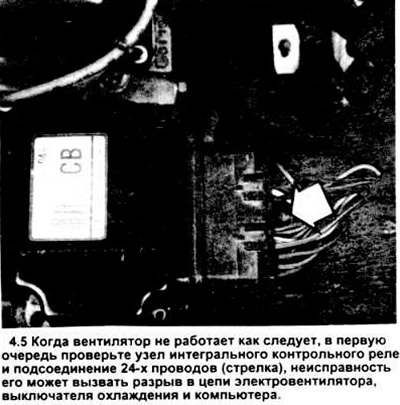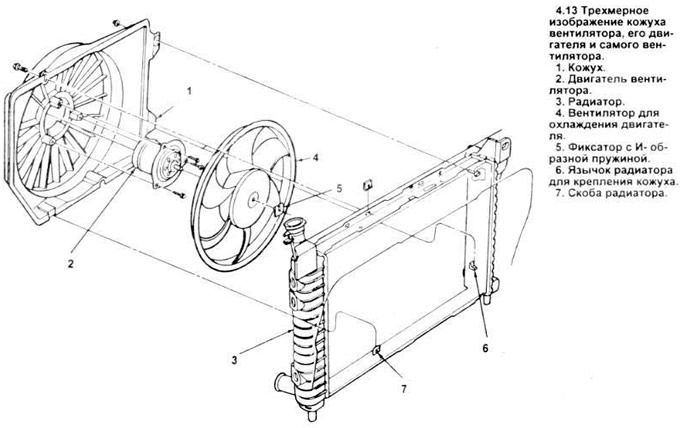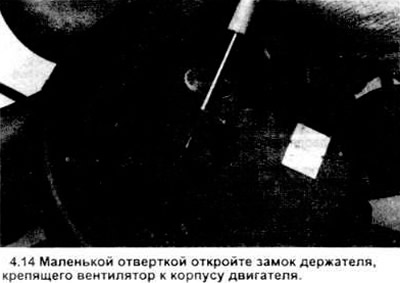Warning: To avoid personal injury, before operating the engine with the hood open, check for possible cracks or damage on the fan. Do not attempt to repair a fan with damaged blades - replace it.
Description
1. The wires of the electric motor are connected in such a way that it operates only when the ignition is on.
Warning: before doing anything under the hood, turn off the electric fan, as it can run with the ignition left in the "included", even if the engine is not running.
2. When the car is moving, the operation of the electric fan is controlled by the integrated control relay and the EEC-4 module, which powers the electric fan under the following conditions:
A) when the engine temperature is above normal (the moment of switching on falls on the temperature range of 102.5-99.7 degrees Celsius (215-210 degrees Fahrenheit)), the fan rotates at low speed. It also turns on when the air conditioner is running, when the vehicle speed does not provide sufficient natural airflow (this effect occurs at speeds between 69 and 77 km/h (43 to 48 mph)).
b) turns off the fan at high speed (except four-cylinder engines with manual transmission), if the engine temperature is above optimum and the fan speed is low (turns on at 110.9 degrees Celsius (230 degrees Fahrenheit), turns off at 107.5 degrees Celsius (224 degrees fahrenheit)).
V) turns off the fan (if the engine coolant temperature is not too high), if throttle is open (fuel consumption is high) and/or the air conditioning is not too busy.
Examination
3. A complete test of this system is not possible, since the electric fan motor is turned on by an integral control relay, which, in turn, is controlled by the EEC-IV system.
However, you can check some items.
4. Remove the fan motor electrical connector and place it on the back of the motor. Remove the plug, make sure that there are no signs of corrosion on it and the terminal. Insert the electrical connector, make sure the installation is secure.
5. Remove the radiator shield (plastic protector with the VECI label on it, make sure the connector of the integrated control relay module containing 24 wires (see picture), connected securely (it is held on by one small bolt, which must be tightly tightened).

6. Inspect the wires between the integral control relay module and the fan, make sure they are in good condition. If they are split or torn, repair them.
7. Using a tester, measure the electrical conductivity between the terminals of the engine cooling thermal switch. Warm up the engine and allow the coolant temperature to reach its operating temperature. When the coolant is heated, the resistance at the terminals of the cooling thermal switch should drop to almost zero and the electrical circuit that supplies current to the fan motor is connected.
A) if the resistance at the terminals of the thermal switch does not drop when the coolant is heated, then the switch is faulty. Replace it.
b) if the resistance at the terminals decreases (when the electric fan circuit is closed), then the switch is OK and the fan can work.
8. When the fan motor does not work, it may be defective. Remove the engine electrical connector, connect a pair of wires with "crocodiles" and fuses to the contacts of the electric fan and battery. If the electric fan does not work, replace it.
9. If the fan works when connected to the battery, then consider these options.
A) there is a break in the circuit somewhere between the switch, the computer, the control relay and the electric motor, in this case the problem is solved by testing with a test light or a tester.
b) if the circuit check did not give anything, then the reason is either in the integrated control relay or in the computer itself.
Replacing elements
10. Disconnect the negative battery cable.
11. Unscrew screws and disconnect the radiator screen. Lay the integral relay assembly on top of the radiator strut. Unscrew the remaining bolt and remove the electrical connector (see figure 4.5), then remove the control unit.
12. Pull out the fan motor electrical connector.
13. To disconnect the fan together with the casing from the radiator, unscrew the nut in the upper left corner of the casing and the bolt in its upper right corner (see picture), then remove the fan and shroud from the mounting tabs on the heatsink.

Note: This assembly may need to be rotated slightly when removed from the engine.
14. Place the fan with shroud on a workbench with the fan on top. Use a small screwdriver to unscrew the holders from the engine mount (see picture) and remove the fan.

15. Remove the three fan motor mounting bolts and disconnect the motor from the shroud assembly.
16. Installation is carried out in the reverse order of disassembly.
Visitor comments